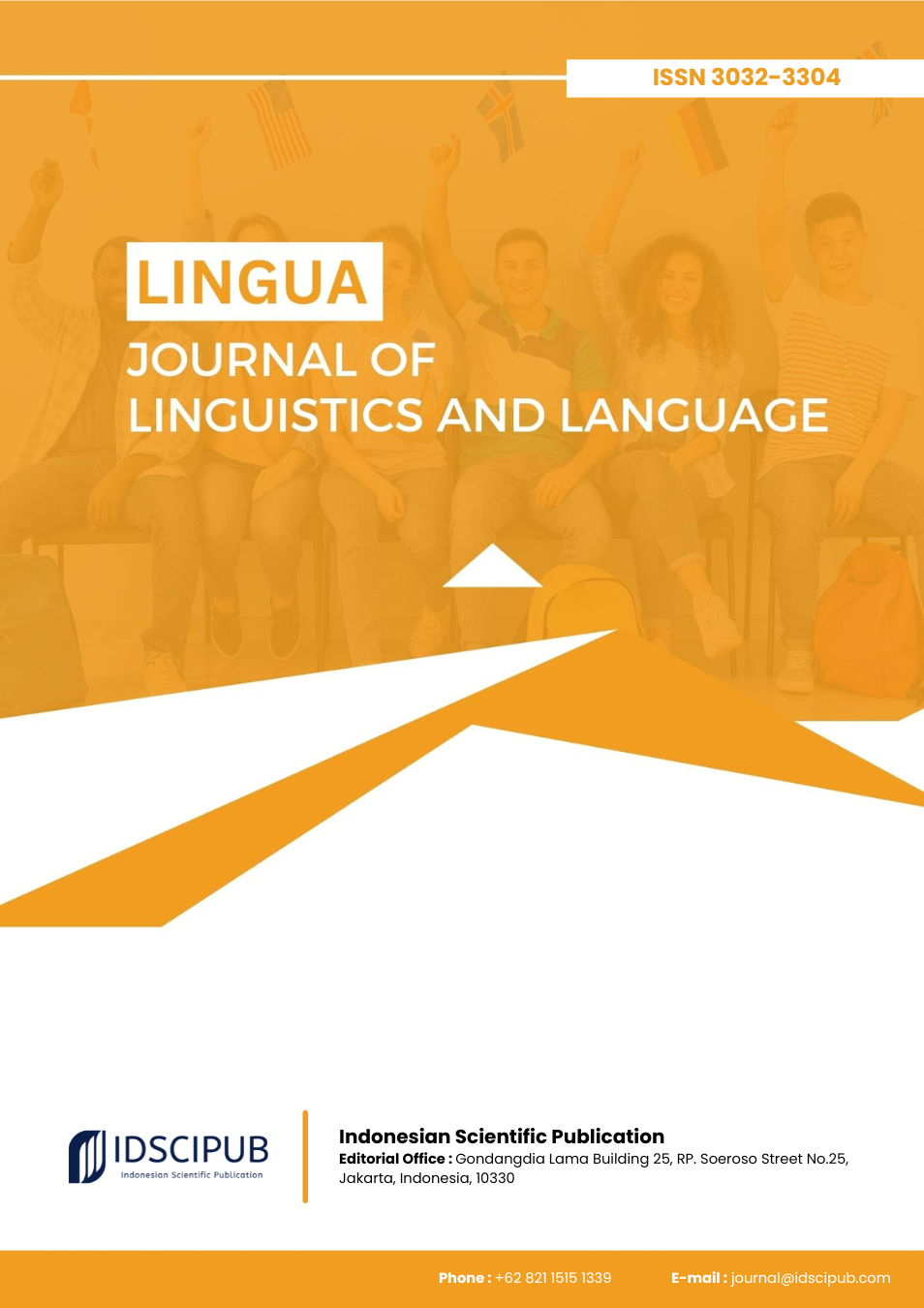Community, Education, and Technology in Language Revitalization: A Narrative Review
DOI:
https://doi.org/10.61978/lingua.v3i2.1039Keywords:
Endangered Languages, Language Revitalization, Linguistic Diversity, Community-Based Strategies, Education Policy, Digital Technology, Cultural HeritageAbstract
Endangered languages are among the most critical challenges in preserving human cultural and intellectual diversity. More than 40% of the world’s 7,000 languages are currently at risk of extinction. This narrative review examines global strategies for language revitalization, focusing on the roles of communities, education, technology, policy, and cultural identity. Literature was gathered from major academic databases (Scopus, PubMed, Google Scholar) using core keywords such as language revitalization and endangered languages. The findings show that community-based initiatives, such as language nests and cultural integration, are crucial for intergenerational transmission. Education policies that include minority languages in school curricula foster measurable gains, while the absence of institutional support often results in stagnation. Digital tools expand access and engagement, though their effectiveness depends on cultural adaptation and community participation. Government recognition and funding further determine success, with marked disparities between developed and developing regions. Overall, language revitalization is not only a linguistic concern but also a matter of identity, cultural resilience, and social justice.
References
Alhazmi, L. (2024). Exploring the inner circle attitudes of endangered languages: a case study of the faifi language. Sage Open, 14(2). https://doi.org/10.1177/21582440241255865 DOI: https://doi.org/10.1177/21582440241255865
Balukh, J., Khairiah, D., Yanti, Y., & Maerina, R. (2024). A phonological sketch of modo: an endangered language in eastern indonesia. Jurnal Arbitrer, 11(4), 516-534. https://doi.org/10.25077/ar.11.4.516-534.2024 DOI: https://doi.org/10.25077/ar.11.4.516-534.2024
Beaton, M., Helander, H., & Keskitalo, P. (2023). Education provision for indigenous and minority heritage languages revitalisation: a study focusing on saami and scottish gaelic., 61-77. https://doi.org/10.1007/978-3-030-97460-2_5 DOI: https://doi.org/10.1007/978-3-030-97460-2_5
Belhiah, H., Majdoubi, M., & Safwate, M. (2020). Language revitalization through the media: a case study of amazigh in morocco. International Journal of the Sociology of Language, 2020(266), 121-141. https://doi.org/10.1515/ijsl-2020-2114 DOI: https://doi.org/10.1515/ijsl-2020-2114
Bracknell, C. (2019). Connecting indigenous song archives to kin, country and language. Journal of Colonialism and Colonial History, 20(2). https://doi.org/10.1353/cch.2019.0016 DOI: https://doi.org/10.1353/cch.2019.0016
Chew, K., Greendeer, N., & Keliiaa, C. (2015). Claiming space: an autoethnographic study of indigenous graduate students engaged in language reclamation. International Journal of Multicultural Education, 17(2), 73. https://doi.org/10.18251/ijme.v17i2.966 DOI: https://doi.org/10.18251/ijme.v17i2.966
Chojnicka, J. (2021). Lower sorbian (new) speakers: questions worth asking. Cognitive Studies | Études Cognitives, (21). https://doi.org/10.11649/cs.2542 DOI: https://doi.org/10.11649/cs.2542
Černý, M. (2022). The role of ofelia zepeda in the tohono o’odham language and cultural revitalization. Český Lid, 109(4), 449-462. https://doi.org/10.21104/cl.2022.4.03 DOI: https://doi.org/10.21104/CL.2022.4.03
Cocq, C. & Steggo, P. (2024). The sámi languages: alive and kicking. Journal of Finnish Studies, 27(2), 231-243. https://doi.org/10.5406/28315081.27.2.05 DOI: https://doi.org/10.5406/28315081.27.2.05
Daigneault, A. & Anderson, G. (2023). Living dictionaries: a platform for indigenous and under-resourced languages. Dictionaries Journal of the Dictionary Society of North America, 44(2), 57-74. https://doi.org/10.1353/dic.2023.a915065 DOI: https://doi.org/10.1353/dic.2023.a915065
Deschene, D. (2019). Coptic language learning and social media. Languages, 4(3), 73. https://doi.org/10.3390/languages4030073 DOI: https://doi.org/10.3390/languages4030073
Fayzrakhmanova, Y. (2025). Digital support for indigenous language revitalization efforts in kamchatka. Sibirica, 24(1), 79-100. https://doi.org/10.3167/sib.2025.240104 DOI: https://doi.org/10.3167/sib.2025.240104
Fine, J. (2019). ‘they just had such a sweet way of speaking’: constructed voices and prosodic styles in kodiak alutiiq. Language & Communication, 67, 1-15. https://doi.org/10.1016/j.langcom.2018.12.002 DOI: https://doi.org/10.1016/j.langcom.2018.12.002
Fujita‐Round, S. (2022). Language communities of the southern ryukyus., 51-58. https://doi.org/10.1093/oso/9780198856610.003.0005 DOI: https://doi.org/10.1093/oso/9780198856610.003.0005
Heinrich, P. (2021). Waves of language diversity loss in japan: an ecological and theoretical account. Journal of Asian Linguistic Anthropology, 3(1), 33-55. https://doi.org/10.47298/jala.v3-i1-a2 DOI: https://doi.org/10.47298/jala.v3-i1-a2
Kandybowicz, J. & Torrence, H. (2017). Africa’s endangered languages.. https://doi.org/10.1093/oso/9780190256340.003.0001 DOI: https://doi.org/10.1093/oso/9780190256340.001.0001
Kissau, S., Davin, K., & Moore, K. (2023). Preparing cherokee language teachers: lessons learned from an innovative licensure program. Journal of Teacher Education, 75(4), 412-423. https://doi.org/10.1177/00224871231165478 DOI: https://doi.org/10.1177/00224871231165478
Lakaw, S. & Friedman, P. (2022). ‘no one at school can speak pangcah’: family language policy in an indigenous home in taiwan. International Journal of Taiwan Studies, 5(2), 249-274. https://doi.org/10.1163/24688800-20221237 DOI: https://doi.org/10.1163/24688800-20221237
Lipski, J. (2020). Language revitalization as l2 shadow boxing. Studies in Second Language Acquisition, 43(1), 220-235. https://doi.org/10.1017/s0272263120000339 DOI: https://doi.org/10.1017/S0272263120000339
Llancao, E. (2019). Technology’s role in mapudungun language teaching and revitalization. Alternative an International Journal of Indigenous Peoples, 15(3), 205-216. https://doi.org/10.1177/1177180119860625 DOI: https://doi.org/10.1177/1177180119860625
Low, D., Mcneill, I., & Day, M. (2022). Endangered languages: a sociocognitive approach to language death, identity loss, and preservation in the age of artificial intelligence. Sustainable Multilingualism, 21(1), 1-25. https://doi.org/10.2478/sm-2022-0011 DOI: https://doi.org/10.2478/sm-2022-0011
Namyalo, S. (2023). Endangerment of ruruuli-lunyala language: past and current trends. Stellenbosch Papers in Linguistics Plus, 66. https://doi.org/10.5842/66-1-862 DOI: https://doi.org/10.5842/66-1-862
Ohara, Y. & Machida, S. (2023). Uchinaaguchi learning through indigenous critical pedagogy: why do some people in yomitan not know yomitan mountain?. Languages, 8(1), 17. https://doi.org/10.3390/languages8010017 DOI: https://doi.org/10.3390/languages8010017
Ramírez-Carbajal, E., Martínez‐Reyes, M., Ayala-Vásquez, O., Evangelista, F., Reyes, M., Hernández‐Santiago, F., … & Pérez‐Moreno, J. (2025). Revitalizing endangered mycocultural heritage in mesoamerica: the case of the tlahuica‐pjiekakjoo culture. Plants People Planet. https://doi.org/10.1002/ppp3.70014 DOI: https://doi.org/10.1002/ppp3.70014
Sallabank, J. (2017). Purism, variation, change and ‘authenticity’: ideological challenges to language revitalisation. European Review, 26(1), 164-178. https://doi.org/10.1017/s1062798717000400 DOI: https://doi.org/10.1017/S1062798717000400
Siragusa, L. (2015). Metaphors of language: the vepsian ecology challenges an international paradigm. Eesti Ja Soome-Ugri Keeleteaduse Ajakiri Journal of Estonian and Finno-Ugric Linguistics, 6(1), 111-137. https://doi.org/10.12697/jeful.2015.6.1.07 DOI: https://doi.org/10.12697/jeful.2015.6.1.07
Tamrin, T., Zalmansyah, A., Yance, I., B., M., Karsana, D., Harum, D., … & Wardhani, A. (2025). Endangered language: preserving totoli language and cultural identity. Theory and Practice in Language Studies, 15(6), 1885-1897. https://doi.org/10.17507/tpls.1506.17 DOI: https://doi.org/10.17507/tpls.1506.17
Zuckermann, G. (2020). Revivalistics. https://doi.org/10.1093/oso/9780199812776.001.0001 DOI: https://doi.org/10.1093/oso/9780199812776.001.0001






